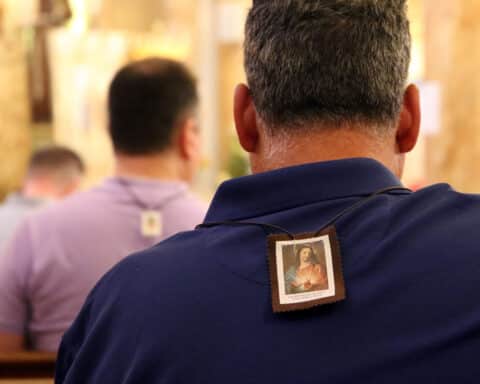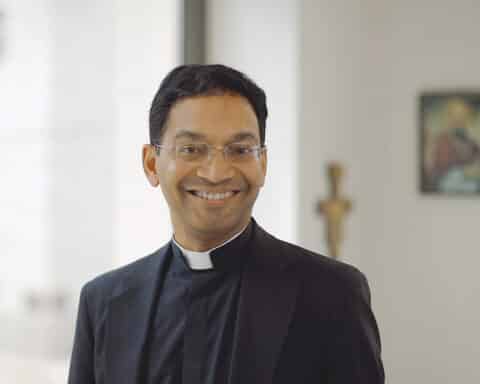There are many things vying for young people’s attention these days. Attention confers authority. Those who receive the most attention tend to wield the greatest influence over our lives, leading to the greatest authority of all: the authority to shape our desires. Whoever can shape young people’s desires most profoundly takes hold of not just the present but also the future.
One of the most challenging and important tasks for parents is forming our children to learn who they can trust with their attention and thus who is worthy of shaping their desires. It is tempting as a parent to try to claim that authority for ourselves, seeking to become the primary and permanent authority over our children’s lives. But not even parents are capable of such lasting authority; rather, our authority is best exercised in showing our children who is truly capable of all their trust, today and always. Amid the cacophony of influences that surround young people today, only one influence never deceives and always is worthy of all our trust: the Word of God.
As I mentioned in my last letter, the Gospels present disciples as “those who hear the word of God and act on it” (Lk 8:21). Actions matter, but hearing comes first. Yet, hearing well is a lot harder than it sounds. Far from a passive exercise, true listening — hearing in a deep and open way — requires practice and strength. Forming our children in the power of attention is, therefore, a matter of training and instruction, helping them to become more capable of what a life of discipleship is built on: the capacity and willingness to hear the Word of God.
From the outset of his Gospel, St. Luke shows us the decisive difference that the willingness and ability to hear the Word of God makes. Prior to defining discipleship, Luke paints a picture of discipleship in the one who hears well and then acts faithfully. He shows us Mary, the first and perfect disciple.
Hearing, in silence
Before the angel appears to Mary in the Gospel of Luke, he appears first to Zechariah, who will become the father of John the Baptist. Did you ever notice how similar these two annunciations are and yet how different they end up? By the end, Mary is exalted as she freely gives her fiat, while Zechariah is punished as his ability to speak is taken away from him. Why this difference when the encounters are so similar? Because Zechariah and Mary respond in subtly different ways to the angel from the start, and as with train tracks, even a small change in direction at the beginning leads to a wildly disparate destination at the end. The subtle difference is hidden in the manners of their silence.

Both Zechariah and Mary respond to the angel Gabriel three times. The third time is the most different: Mary speaks freely when she declares, “Behold, I am the handmaid of the Lord. May it be done to me according to your word” (Lk 1:38), while Zechariah is unable to speak because he “did not believe [the angel’s] words” (1:20). The second time is modestly different, as Mary asks “How can this be, since I have no relations with a man?” (1:34), while Zechariah asks “How shall I know this? For I am an old man, and my wife is advanced in years” (1:18).
The first time they respond though, the difference is very subtle, yet decisive. When the angel appears to Zechariah, we are told that “Zechariah was troubled [tarassō in Greek] by what he saw, and fear came upon him” (1:12). When the angel later appears to Mary, the first part is not just similar but indeed even stronger: “[S]he was greatly troubled [diatarassō in Greek] at what was said” 1:29). If Zechariah was troubled and then feared, we should expect that Mary, who was greatly troubled, should be even more fearful than Zechariah was. But what are we told instead? Rather than being fearful, she “pondered what sort of greeting this might be” (1:29).
The first thing Zechariah does is recoil in fear, while the first thing Mary does is open herself to ponder. These things happen in silence: one of them is on the defensive, the other is available. It is easy to just pass by this subtle difference without taking note of it, but St. Luke gives us these two annunciations in such a similar fashion so that, if we pay attention to the word of God here, we ourselves will ponder the significance of this difference.
From the start, Mary, who is the living image of discipleship, is willing and able to listen to the word of God even and especially when she is not in control. Zechariah, meanwhile, gropes for control out of fear. The questions that each of them asks testify to this, as Zechariah asks, “How can I know this?” while Mary asks, “How can this be?” One of them places himself at the center and basically says “prove it to me” while the other seeks to understand what she is willing to believe is true.
As Luke’s infancy narrative continues, this willingness and ability to “ponder” becomes Mary’s defining characteristic. She ponders the angelic announcement the shepherds proclaim (cf. Lk 2:18-19), the words of Simeon in the temple (cf. 2:33-35), and the encounter with Jesus himself in the temple (cf. 2:50-51). Zechariah was uncomfortable when the Word of God stirred in the silence, while Mary opened herself more and more to this Word, even allowing this Word to tenderize her heart. Discipleship begins with the willingness to remain in silence and the ability to receive what the Lord may give to the one who is listening.
Silent on purpose
In our modern environment where everything is vying for young people’s attention, their default mode is typically one of reacting to new stimuli rapidly. How, then, do we, as parents, help them to develop in the power of attention? The Trappist monk Thomas Merton offers some guidance in “The Sign of Jonas” (Harcourt, $21.95):
“What to do? Those who love God should attempt to preserve or create an atmosphere in which He can be found. Christians should have quiet homes. Throw out the television [and other screens], if necessary — not everybody, but those who take this sort of thing seriously. … Let those who can stand a little silence find other people who like silence, and create silence and peace for one another. Bring up their kids not to yell so much. Children are naturally quiet — if they are left alone and not given the needle from the cradle upward, in order that they may develop into citizens of a state in which everybody yells and is yelled at. Provide people with places where they can go to be quiet — relax minds and hearts in the presence of God.”
The world is full of noise, so practicing silence must be an intentional practice. Young people will not become comfortable with silence if they are not regularly given opportunities to spend time in silence. Space and time away from “all the other things” (cf. Mt 6:33) is required if the power to shape our desires is to be rescued from all the other influences and given above all to God.

And how do we practice welcoming God into the silence? By actively setting our attention on his word, principally through Scripture. This, too, is featured in Mary’s annunciation narrative, though I can only mention it here briefly.
Mary’s memory is filled with Scripture. For example, when the angel proclaims to her that Elizabeth, who is old and barren, is with child, she recognizes in this the sign of the only other person in Scripture who bears those marks: Sarah, Abraham’s wife. Mary recognizes that what began in Sarah is now complete in Elizabeth, while Zechariah failed to grasp the sign that his own wife is because his memory was not then alive with Scripture. The announcement of Elizabeth’s pregnancy was the last thing Mary heard before she said “yes”; in other words, she knew who she was saying “yes” to the Word of God.
Sincerely,






